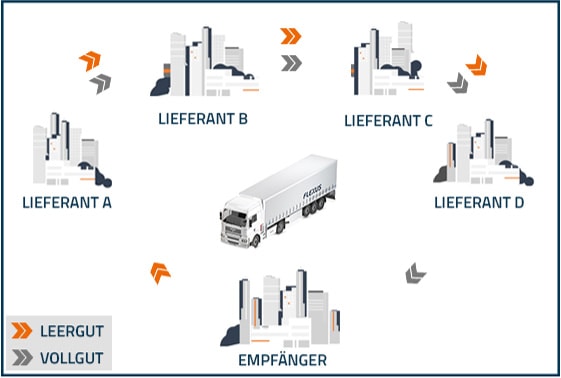Milk runs in logistics as a concept for cost savings
Logistics costs and services do nowadays increasingly determine the value and price of products for the customer. In times of economic weakness, the margins of companies are declining. Volume losses can only partially be compensated for by price reductions. However, lower production volumes also mean higher fixed costs and thus lower margins. Reduced unit volumes lead to a reduction in transport volumes. Yet, new routes and increased consolidations simultaneously lead to higher transport costs. As a result, there is an increasing trend towards the optimization of transport costs, for example by making use of the milk run concept.
Definition: What is the milk run system?
The term milk run originates from the delivery of fresh milk, where the milkman took a fixed route to his customers. If the customer left an empty milk bottle at the doorstep, the milkman would exchange it for a full bottle of milk. These days, milk run simply refers to a logistics concept.
Milk runs in logistics characterize a continuous removal of transport goods from different sources of supply as well as a direct delivery to the respective target plant without an intermediary collection site. The milk run concept is not tied to a specific means of transportation, but it is mostly realized using trucks due to the high flexibility requirements of the schedules and the maximum accessibility.

How to plan milk run route?
With milk runs, the route is developed step by step and different requirements are considered:
- Time limits: At what time must the goods to be transported arrive at the plant at the latest?
- Calculation of the maximum suppliers:
a. What is the maximum possible lead time?
b. How long does it take to load and unload the trucks?
c. How high is the spatial concentration of the sources?
d. How long is the distance to the plant?
e. At what speed can the trucks be driven? - Clustering of milk runs: Based on the transport volume and pickup frequency, it is possible to re-group different milk runs.
- Milk runconfiguration: Next, the milk run is configured in detail.
- Sequence: Definition of a pickup sequence at the different suppliers and outline of the different options.
- Option selection: In the last step, the different options are compared with each other and the final milk run route is selected.
Advantages of the milk run concept
Perhaps the greatest saving potential and therefore the most significant advantage of the milk run system involves the reduction of transport costs. On average, savings of 20% in transport costs can be achieved by switching from non-optimized transport systems to the milk run. Savings of more than 50% are not uncommon. Fixed and variable costs are generally incurred for any transport, regardless of its workload.
The proportional transport costs incurred per transported unit increase with a declining workload. This leads to the conclusion that a means of transportation with low workload leads to higher transportation costs than one with a high workload. By combining several supplier-receiver relationships with low or no utilization, as is often the case with non-optimized supply systems, the milk run concept results in a collective transport with high workload and additional return of empties. Depending on the circumstances, the achievable transport workload can be a lot higher.
Requirements for milk runs in logistics
The main limitation for of milk run systems in logistics is the required spatial proximity between the different suppliers. Milk runs generally describe a round trip from one supplier to another and back to the starting point. The limiting factor for these round trips is the time required. This legally regulated driving time cannot be fully utilized due to the fixed trip times of the delivery and pickup points at suppliers and customers. These restrictions on the maximum length of a milk run round trip do naturally also limit the radius in which suppliers and the starting/end point of a milk run must be located at.
